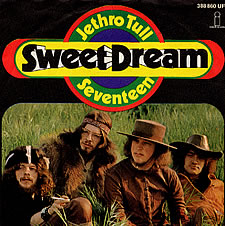| "Sweet Dream" | ||||
|---|---|---|---|---|
 Jethro Tull Sweet Dream German 7" Single | ||||
| Single by Jethro Tull | ||||
| B-side | "17" | |||
| Released | 3 October 1969 [1] [2] | |||
| Recorded | 31 August / 11 September 1969 [1] [2] [3] | |||
| Studio | Morgan Studios, London, England [3] | |||
| Genre | Hard rock | |||
| Length | 4:05 | |||
| Label | Chrysalis, Island, Reprise, Fontana | |||
| Songwriter | Ian Anderson | |||
| Producer | Ian Anderson | |||
| Jethro Tull singles chronology | ||||
| ||||
"Sweet Dream" is a song recorded by English rock band Jethro Tull on 31 August 1969, at Morgan Studios, London. It was their second consecutive UK top ten single, reaching number 7 on the UK singles chart. [4] The B-side was a non-album track, "17", recorded on 11 September 1969, also at Morgan. It later appeared as a bonus track on remastered versions of Stand Up . [5] "Sweet Dream" has appeared on many of the band's compilation albums, while "17" has been rarely seen. In the UK, the single was the first release on Chrysalis Records.
Contents
The song was included on the 1972 Warner/Reprise sampler album, The Whole Burbank Catalog. This was the first US release.